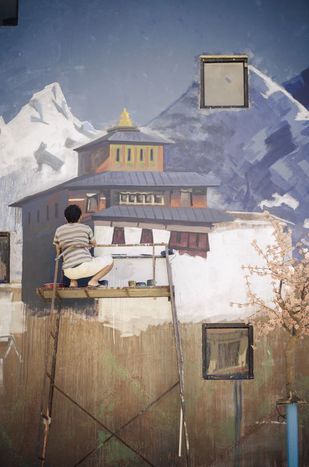
Painting dreams : Kathmandu's freshly emerging street art scene
Published on
Nepal is struggling. Most Nepalis are facing problems concerning their water and electricity supply, all are living in an environment of political uncertainty. Yet, there is a bunch of people believing that there is still some space left for beauty and new ideas. Maybe more than ever.
Entering the ground of the Sattya Media Arts Collective, I find myself in an enclave of peace. A group of people is sitting around a table in the sun, holding the weekly team meeting. Behind them, the colourful three-storey building looks like a stronghold of creative energy.
Bringing colour to the city
This impression reinforces itself while Lisa, the management intern, shows me around. There’s a small and cosy library furnished with cushions on the floor, right next to the new co-working space. From now on, it will provide the opportunity for young professionals to get a cheap office place and to exchange with others. Other projects are the community garden Hariyo Chowk or the documentary screenings that hold place once a week. Nevertheless, the action for which Sattya got the most attention is “Kolor Kathmandu”. Within one year, the goal was: getting national and international artists to paint 75 murals in Kathmandu, representing the country’s districts. In short – make Kathmandu more colourful.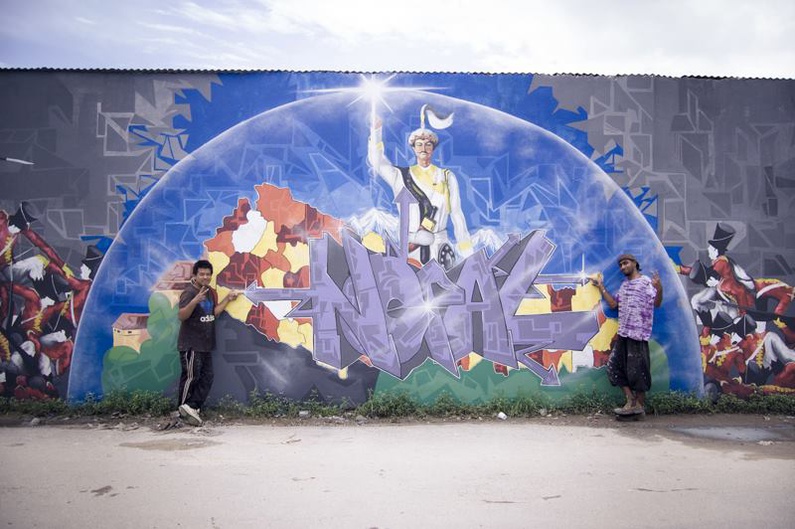
Regain public spaces
Some of the artists participating felt like fighting against “hollow political slogans” and ubiquitous advertising to regain public spaces for the public itself. One of them is Aditya Aryal, aka SadhuX. The fact that he began painting only three years ago shows how uncommon street art was until recently. As the creative head of the association Artlab, he wants to change this; just like Romel Bhattarai, Artlab’s managing director.
“We want to make people more curious.”
“There was nothing until we began painting on the streets. The art scene was concentrated on exhibitions in galleries”, Aditya begins. Romel takes over, stating:”We want to break the structures of galleries that are often very sophisticated”. Nepalis interested in art shall go on the street and perform rather than wait for a gallerist to come to them. “A lot of artists in Nepal are waiting. We are creating. No matter how and where”. Bringing art to the street makes the oeuvre accessible for everyone. “We want to make people more curious.” Questioning the public cannot happen in the haven of galleries that always attract the same kind of people.
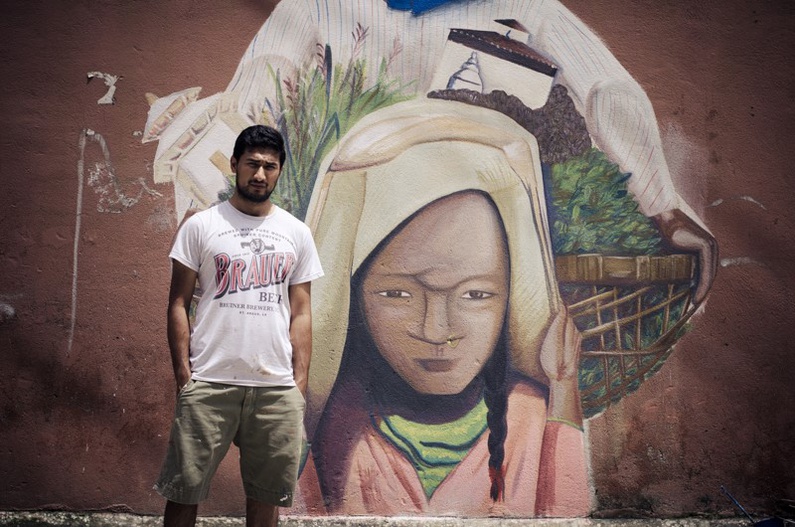
Dreamers with a sense of business
“When I began making art, it was more for this feeling of intangible satisfaction it gets you”, Priti Sherchan, the artist coordinator at Sattya, tells me. “But later, I began to see also the economical benefit of it. Even on this small scale, we provide jobs for the people who produce our colour or the drivers who move art pieces”.
The artists of Artlab go even further in demonstrating that art and especially street art is not necessarily some kind of pass-time dependent on generous sponsors but has tangible links with the commercial world. What began as a work for purely ideological reward has become a somewhat lucrative business by now. “The work we do on the street is like a promotion for our other pieces”. The five artists along with their manager find ways of keeping the business going: They try to create products for sale like T-Shirts and prints whenever possible and paint buildings on request. In this fashion, the artists’ collective got paid for painting murals like in the Places Bar and Restaurant in Thamel, where they also display pieces of their latest projects for sale.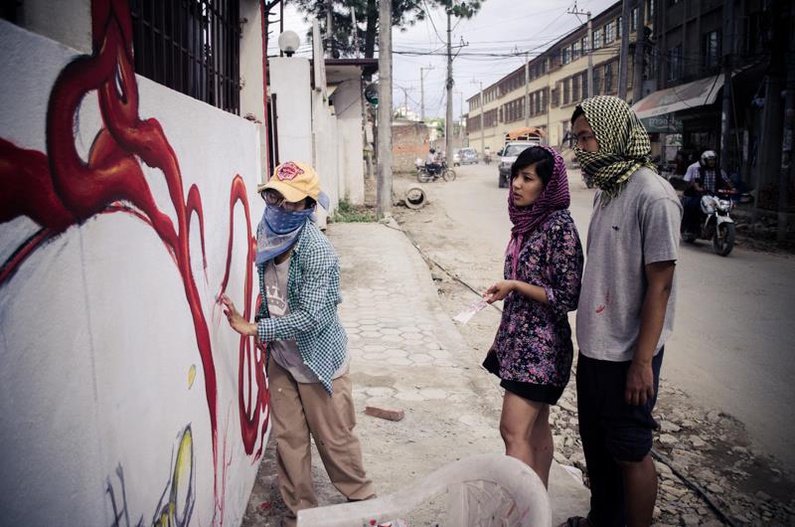
The non-for-profit organization Sattya, too, got one foot into business through its affiliated creative agency Sattya Inc. Its purpose is, effectively, to bring artists and potential clients together in order to satisfy the growing demand of creative space design along with the needs of artists to sustain themselves through their work.
Implementing new structures
So, where is this leading, actually? “Of course we’ve got a vision”, Romel says with the smile of the truly enthused. “We want to see art everywhere”. He has got a rather clear idea of how to approach this skyscraping goal. That he is a manager is visible as he details how Artlab is going to expand. New structures will create opportunities and a platform not only for artists but also for others in the creative business. Why not bring together designers and information scientists? After all, there’s a whole industry to explore!
Learning from abroad
The next big project Romel is dreaming of is an international street art festival within the next year that will bring together foreign and local artists. “There is no style yet in Nepali street art”, Aditya puts it. But this is maybe the biggest trump of those being creative here. Clearly influenced by the street art scene of cities like New York or Berlin, Nepalese artists though have the freedom to do something completely new, to feel again like children with pots of paint in front of a surface to fill.
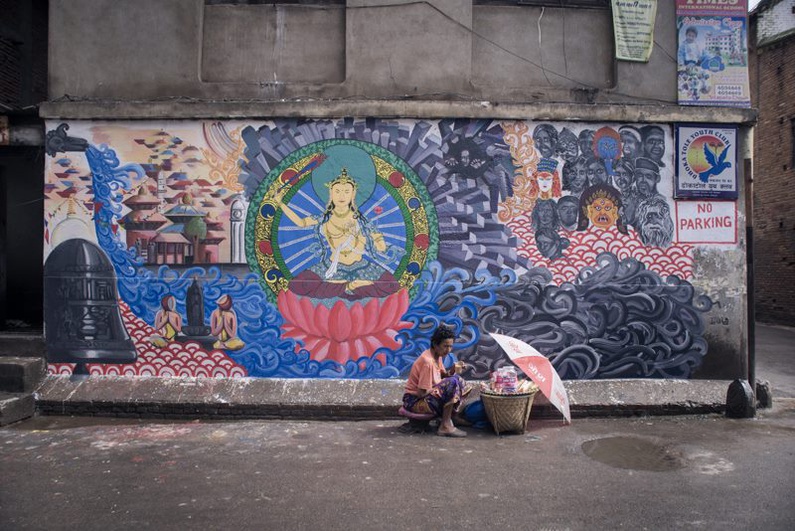 A sense of belonging
A sense of belonging
This generation of artists in Kathmandu is unified by the desire to make a change on the spot. Unlike a lot of other young people, they don’t want to go away. Artlab’s current project, Prasad, addresses the problem of the youth searching their luck abroad. By painting “Nepali heroes”, they want to inspire their generation to invest their individual potential in their home country. Sattya for its part provides – through its office and workshops – spaces to get together and to meet other people with new ideas. “We want to build a community and create a sense of belonging”.
Start where you stand – and go far
Those people are not primarily dreamers. They are makers. They create as they go, show, inspire. “Start where you stand”. This is Sattya’s motto. The same sense of grounded willingness comes through when Priti answers my questions that are the questions of the hesitating: How will it work? Why you? And why now? She looks me in the eyes and simply says: “Someone has to do it".



